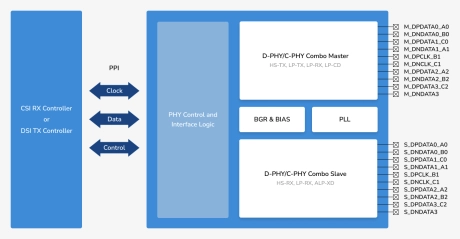MIPI IP
MIPI IP cores enable seamless communication between processors, sensors, and peripherals in mobile, automotive, and consumer electronics applications. Two key components of MIPI IP cores are the MIPI Controller IP and MIPI PHY IP. The MIPI Controller IP manages the data transfer process, ensuring efficient and reliable communication between devices, while the MIPI PHY IP handles the physical layer of the interface, ensuring high-speed, noise-resistant signal transmission.
Explore our vast directory of MIPI IP cores below.
All offers in
MIPI IP
Filter
Compare
696
MIPI IP
from
52
vendors
(1
-
10)
-
Simulation VIP for MIPI CSI-2
- Support testbench language interfaces for SystemVerilog, UVM, OVM, e, and SystemC
- Generates constrained-random bus traffic with predefined error injection at CSI-2, D-PHY, C-PHY and A-PHY levels
- Callbacks access at multiple TX and RX queue points for scoreboarding and data manipulation
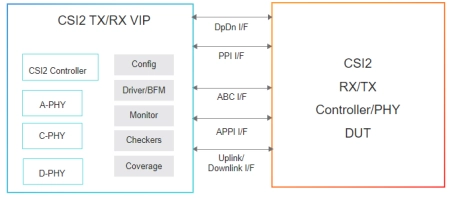
-
Simulation VIP for MIPI M-PHY
- Specification Compliance
- Complies with MIPI M-PHY 4.0, 4.1 and 5.0 specification
- M-PHY Type 1 and Type 2
- Supports Type 1 and Type 2
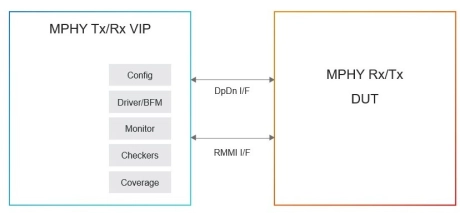
-
Simulation VIP for MIPI UniPro
- Compliance: Contains predefined checks to verify that the DUT agents adhere to the protocol rules
- Error detection: Supports error detection on all layers, more than 240 different protocol checks
- Coverage: Monitors, checks, and collects coverage on bus traffic using hundreds of automatic protocol checks, including configuration and runtime checks
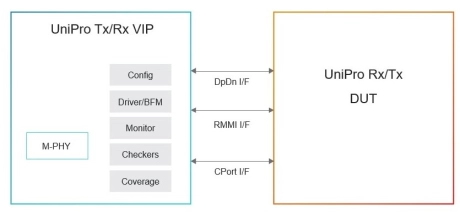
-
MIPI SoundWire I3S Manager IP
- The MIPI SoundWire I3S Manager IP enables efficient, low-power, and high-fidelity audio data transfer for mobile, consumer, and automotive applications.
- Compliant with the MIPI SoundWire I3S (Inter-IC Sound) standards, it supports synchronized, multi-channel audio over a scalable two-wire interface, ideal for connecting digital microphones, amplifiers, and codecs in space-constrained designs.
-
MIPI SoundWire I3S Peripheral IP
- The MIPI SoundWire I3S Peripheral IP delivers seamless, low-power, and high-quality audio connectivity for a range of mobile, consumer, and automotive devices.
- Fully compliant with the MIPI SoundWire I3S (Inter-IC Sound) specifications, it enables synchronized, multi-channel audio communication with a compact and efficient two-wire interface, ideal for integrating digital microphones, amplifiers, or audio codecs.
-
MIPI SoundWire I3S Verification IP
- Full MIPI SoundWire I3S Master, Slave and Monitor functionality
- Supports MIPI Soundwire-I3S Bus Draft Specification v0.4r06.
- Supports system with one master and one or more slaves (upto 8 slaves).
- Supports LVDS PHY for higher speed and a single-ended CMOS PHY for lower speed systems.
-
MIPI CSI2 Interface Solution
- Brite provides full solution for the MIPI CSI interface, which receives the data from sensors in PHY layer, and then converts the byte data to pixel after lane data mergence.
- Data scramble is an optional feature to decrease the EMI effect.
- A standard PPI interface is implemented for the connection between MIPI PHY and CSI controller. Brite MIPI CSI interface solution supports image applications with varying pixel formats.
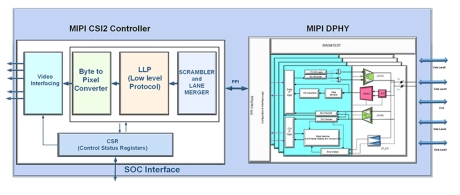
-
MIPI D-PHY - 28nm, 14nm, 8nm, 5nm, 4nm
- The MIPI D-PHY IP is a hard-macro PHY for CSI RX and DSI TX. IO pads and EDS structures are included.
- In addition, extensive built-in self-test features, such as loopback and scan, are supported.
- It offers a cost-effective and low-power solution.
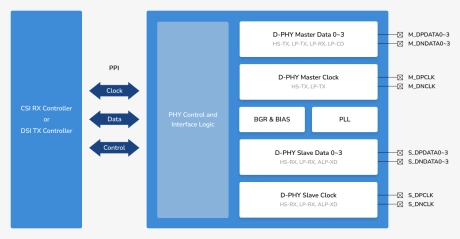
-
MIPI C-PHY - 28nm, 14nm, 8nm, 5nm, 4nm
- The MIPI C-PHY IP is a hard-macro PHY for CSI RX. IO pads and ESD structures are included.
- In addition, extensive built-in self-test features, such as loopback and scan, are supported.
- It offers a cost-effective and low power solution.
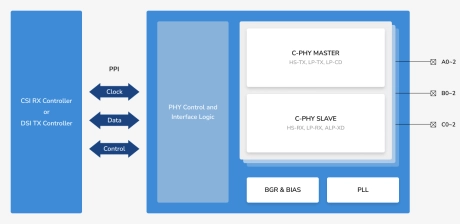
-
MIPI C-PHY TRx / MIPI D-PHY TRx Combo PHY - 14nm, 8nm, 5nm, 4nm
- The MIPI D-PHY/C-PHY Combo IP is a hard-macro PHY for CSI RX or DSI TX. IO pads and ESD structures are included.
- In addition, extensive built-in self-test features, such as loopback and scan, are supported.
- It offers a cost-effective and low-power solution.
